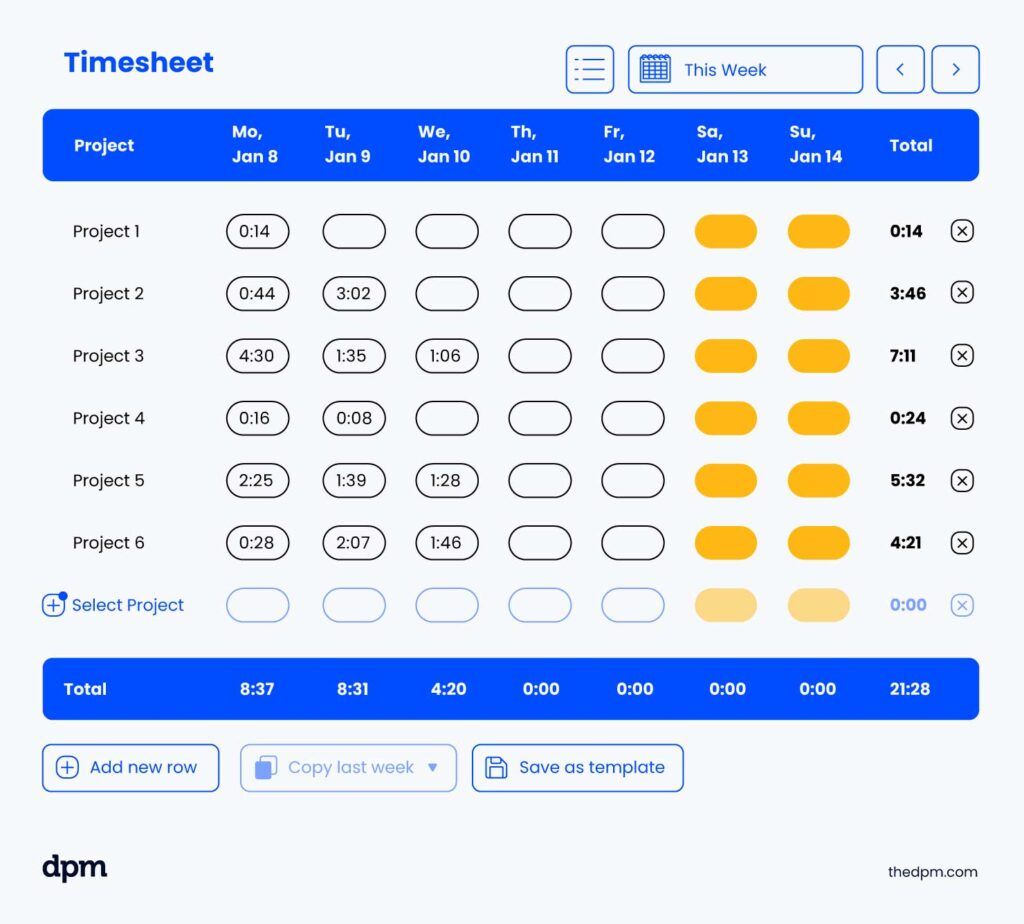Time tracking? Who has time for that? Especially project managers whose schedules are hectic on a good workday. But it's essential—tracking time increases project efficiency and success, improves time management, and assists with everything from project planning to risk management.
As I’ll provide more detail on later, you’ll want to use time tracking software, rather than asking your team to track their time on paper or in a spreadsheet.
What Is Time Tracking?
Time tracking is a process by which project managers keep track of the hours team members spend on project-specific tasks and the entire project. This helps measure and manage project team effectiveness, create project estimates, and set team schedules.
Is Time Tracking Just A Form of Micromanagement?
No, time tracking is not about having a time tracker to monitor employee time entries, absences, or when team members clock in for micromanagement purposes. It's quite the opposite. No one benefits from micromanagement.

In short, the purpose of time tracking is to ensure project teams are working smarter, not harder.
Project teams are busy and need to spend their time efficiently and effectively. Here's how I've explained time tracking to teams in the past:
Time tracking is a powerful tool for gathering accurate time-related data about precious work hours, allowing us to find areas for improvement in workflows, remove bottlenecks, cut out waste, and increase our impact through higher-value work. Ultimately, it empowers us all to achieve far better results without being overworked and overwhelmed—and there are other valuable benefits.
Project teams tend to hate time tracking. Find out more about why time tracking is bad, according to teams, and how to counter.
5 Time Tracking Benefits
Time tracking benefits include providing greater visibility into how and where resources and time are spent, reducing risks, and opening up streamlining or other opportunities—benefiting project managers, project sponsors, teams, and other stakeholders.
1. Project Planning
Project planning isn't always the most exciting part of project management, but it can be simplified using the right tools—and time tracking is one of the tools. In my experience, being able to plan for the optimal use of resources and schedule employee time without overburdening teams can be one of the most stressful elements, especially in complex projects.
Project managers use time tracking data to help team members leverage their highest-value skills and capabilities where and when it matters the most. This helps to reduce stress and burnout and increases the chances of meeting quality deliverables and project goals.
Deloitte's Burnout study shows that 91% of employees say having an unmanageable amount of stress or frustration negatively impacts the quality of their work, and 77% say they have experienced employee burnout at their current job, with more than half citing more than one occurrence.
Tracking time also plays a vital role in planning future projects, using lessons learned from collected data to address mistakes and help teams step up their performance.
2. Team Productivity
Tracking and ensuring employee productivity is vital to delivering stakeholder value and achieving project success. Take meetings, for example. Did you know that employees attend, on average, 11 to 15 meetings per week? This is likely higher for project teams. Yet, not all meetings accomplish something.
Without time tracking, there's no way to know if that meeting time is well spent or have meaningful conversations about what's not working.
Almost 35% of team members feel that at least five work hours in weekly meetings don't accomplish anything. That's a lot of wasted time and cost each year.
Tracking time over the years allowed me to isolate and reduce rework, errors, and team fatigue that could jeopardize project deadlines. It helped my teams become far more efficient, ineffective, and empowered.
3. Setting Clear Expectations
Tracking time is more than invoicing the number of billable hours team members put into a project. Project managers need to get a full view of how their teams are spending their time. It helps in prioritizing and communicating information and concerns about tasks.
A Gallup study on employee engagement found that setting clear expectations increases productivity by 10% and reduces turnover by 22%.
Project managers use data to set clear expectations, which helps increase engagement and buy-in and ensures project teams are highly productive, delivering exceptional results on time.
4. Risk Management
Assessing risks and how effectively time, project budgets, and resources are being managed, especially in larger organizations, relies on project time tracking to answer questions like these:
- Is your project on track?
- Is the project over budget?
- Which resources are available and where?
- How many hours have been used and are needed?
- Where has the most time been spent?
Project managers use time tracking data to assess project progress, answer tough questions, and more rapidly see where the wheels could fall off the wagon. It also allows more time to make the necessary changes for optimal risk mitigation.
5. Project Profitability
You know the adage—time is money. It couldn't be more accurate in project management, where budgets and time must be precisely balanced to meet project goals. Projects must deliver value in one form or another. More often, financial benefits.
Poor project time management leads to overspending. Tracking actual team hours versus budgeted hours is a key element in understanding resourcing, burn rates, and projected financial gain or loss of a project. It ensures that a project manager can accurately estimate, budget, and monitor project costs and adjust when and where needed to remain profitable.
Time Tracking Best Practices
Before you dive into tracking how and where your project team spends their time, you'll want to set some time tracking best practices to ensure the benefits are there and everyone's on the same page.
1. Identify What Data You Want To Collect And Analyze
Usually, I would say it's important first to let your team know you want them to track their time, but odds are, they'll have questions about what is being tracked.
You need to map out the type of project-specific data that's important to collect and analyze before you can ask employees to track their time. Some common details include employee time and related details, the different project(s) they're working on, their schedule, hourly rates, and budgeted hours. Team members will need to be able to complete fields like the actual amount of time they worked each day, the tasks, and the project to bill clients accurately.
2. Communicate Time Tracking With Your Team
Now that you've identified the types of data you'll need to be effective, you're prepared to provide answers. You should also be transparent about why this information is essential and what you plan to do with it. This will help put your team at ease—be prepared to answer additional questions.
3. Select Time Tracking Software
Whether you work with a large enterprise or small business, work time is limited, so selecting the right time tracking tool to collect, store, analyze, and share real-time time tracking details is essential.
Resist the urge to use Excel spreadsheets and templates. You’ll want modern, robust, scalable, and automatic time tracking software to summarize timesheets into time reports for quick and easy analysis. Most of all, find a solution that will need to meet the needs of all of your company's projects. Make sure to get feedback from the team members who will be using the software.

Tip: Also, check out project management software that has built-in time trackers.
4. Train Your Team Members To Use Time Tracking Software
If you've landed on the right time tracking tool or project management tool, it's essential that you take the time to train your team members on how to use it. After all, they will be the primary users and the more knowledgeable they are, the better results you'll have. Whether you’re working with large or small teams, be prepared to create a user manual to make timekeeping easy for current and future employees.
Tip: Remote teams might also need access to time tracking apps to track hours on their mobile devices on the go.
5. Analyze the Data and Discuss The Findings With Your Teams
Once your team members have started entering actual data, you're ready to analyze it and share the findings. This will help you and your team make important decisions about how work gets done and look for improvements.
Time Tracking Software For Project Management
We've done the leg work for you and compiled a list of the best time tracking software.
10 Best Time Tracking Software Shortlist
Here's my pick of the 10 best software from the 10 tools reviewed.
What’s Next?
Want to connect with other digital project managers to share resources and best practices? Join our membership community and get access to 100+ templates, samples, and examples and connect with 100s of other digital project managers in Slack.


